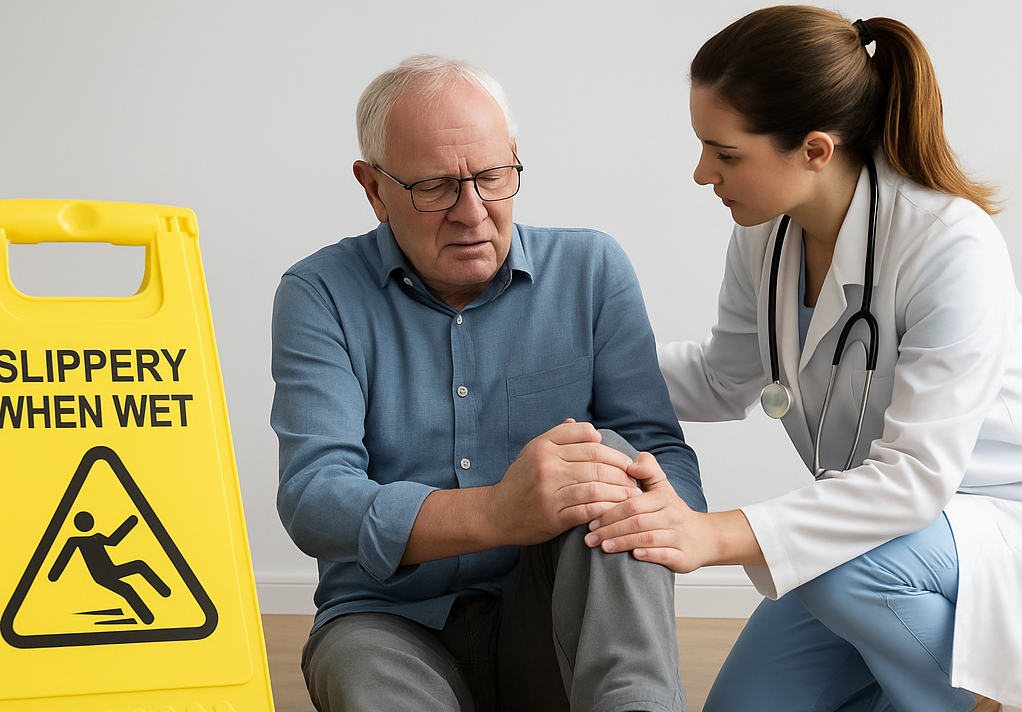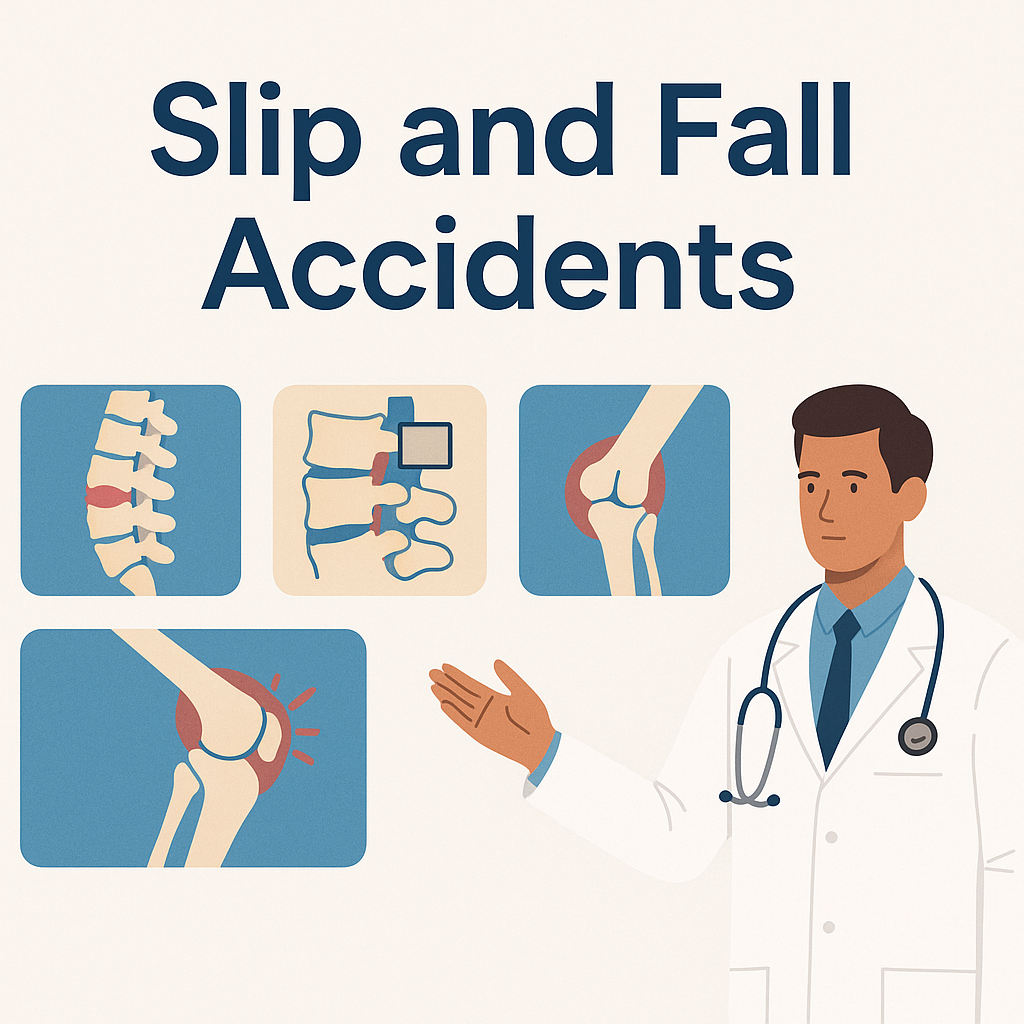Our experienced team provides comprehensive care for slip and fall injuries. From initial evaluation and personalized treatment plans to pain management and rehabilitation, we’re here to support your full physical recovery and long-term well-being.
What to Expect from Our Slip and Fall Accident Treatment:

At Spine Muscle and Joint, we recognize that slip and fall accidents can lead to more than just temporary discomfort—they can cause lasting damage if not properly addressed. These injuries often involve soft tissue trauma, joint misalignment, nerve compression, or even bone fractures. Without timely and effective treatment, they can result in chronic pain, reduced mobility, and long-term health complications. Our experienced team takes a thorough, multi-disciplinary approach that combines advanced diagnostics, personalized care plans, and rehabilitative therapies to help you recover fully, restore function, and prevent future issues.
Comprehensive Care Approach:
- Detailed injury evaluation and diagnostic imaging to identify fractures, soft tissue damage, or joint issues.
- Customized physical rehabilitation to restore strength, balance, and function while reducing the risk of reinjury.
- Joint and spinal alignment therapies to correct biomechanical issues caused by falls.
- Pain relief management including manual therapy, medication, and non-invasive techniques tailored to your recovery needs.
- Fall prevention education and training to enhance coordination and minimize future risk.
- Psychological support for anxiety or fear of falling again, ensuring a confident return to normal activities.
How Slip and Fall Incidents Lead to Serious Injuries:

Slip and fall injuries can happen in a variety of environments and often result in serious musculoskeletal trauma. These incidents may occur on wet floors, uneven surfaces, icy walkways or poorly lit staircases. Depending on the mechanism and severity of the fall, injuries.
• Herniated or Bulging Discs
These occur when the soft inner material of a spinal disc pushes through a tear in the tougher exterior. This can compress nearby nerves, leading to pain, numbness, or weakness in the limbs. Such injuries often require imaging for diagnosis and may necessitate physical therapy, injections, or even surgery.
• Spinal Misalignment and Vertebral Compression
Falls can cause the vertebrae to shift out of alignment or compress, especially in the lower back. This can result in persistent pain, reduced mobility, and in severe cases, nerve impingement. Treatment may include chiropractic care, spinal decompression therapy, or long-term pain management strategies.
• Knee, Hip, or Shoulder Joint Damage
The impact of a fall can place sudden, unnatural stress on major joints, leading to ligament tears, dislocations, or fractures. Hips and knees are especially vulnerable during sideways or backward falls, while shoulder injuries often occur when trying to break a fall with the arm.
• Wrist and Elbow Injuries from Bracing During the Fall
It’s instinctive to extend the hands during a fall to prevent head or torso injury. Unfortunately, this can result in sprains, fractures, or dislocations of the wrist or elbow. These injuries may require splinting, casting, or surgical intervention depending on severity.
• Chronic Back Pain and Soft Tissue Inflammation
Even when no bones are broken, soft tissues such as muscles, ligaments, and tendons can suffer strain or tearing. This often leads to long-term inflammation, stiffness, and chronic pain. Rehabilitation typically involves physical therapy, anti-inflammatory medications, and ongoing pain management.
Comprehensive Evaluation and Personalized Treatment Plans
At Spine Muscle and Joint, we prioritize precision and individualized care for every patient. Our process begins with a thorough physical examination, followed by advanced diagnostic imaging to accurately assess the extent and origin of your condition. We utilize cutting-edge technologies such as:

- C-Arm Fluoroscopy – Real-time X-ray imaging that allows for highly accurate guidance during diagnostic and therapeutic procedures.
- X-Rays – Used to identify fractures, joint misalignments, and degenerative changes in the spine and other joints.
- Ultrasound Imaging – Provides detailed views of muscles, tendons, and ligaments, enabling dynamic assessment of soft tissue injuries.
Following your evaluation, we design a customized treatment plan aimed at addressing both immediate symptoms and long-term recovery. Treatments may include:
- Medication Management : We prescribe and monitor medications specifically tailored to reduce inflammation, manage acute pain, and improve your daily functioning. Our focus is on safe, evidence-based use of pharmaceuticals, often as part of a broader care plan.
- Targeted Joint and Epidural Injections : For patients with localized joint pain or nerve root irritation, we offer image-guided injections using C-Arm fluoroscopy. These injections deliver anti-inflammatory medication directly to the affected area, offering fast-acting and precise relief for conditions such as sciatica, facet joint syndrome, or bursitis.
- Physical Rehabilitation : Our rehab programs are designed to rebuild strength, improve balance, restore flexibility, and promote coordination. Through customized exercise routines and manual therapy, we aim to return patients to full function and prevent future injuries.
- Trigger Point Therapy : For chronic soft tissue pain, we offer trigger point therapy to release tension knots within muscles. This technique targets painful, contracted muscle fibers to alleviate stiffness, reduce referred pain, and improve mobility.
By combining diagnostic accuracy with a multi-modal treatment approach, we help our patients recover faster and achieve lasting relief from spine, muscle, and joint conditions.
Clinical Hypnosis for Holistic Healing and Recovery
At Spine Muscle and Joint, we recognize that healing from an injury involves more than just addressing physical symptoms. That’s why we offer clinical hypnosis as a complementary therapy to support the mental and emotional aspects of recovery. This evidence-based approach can significantly enhance traditional medical treatments by helping patients manage pain, reduce stress, and promote overall well-being.
How Clinical Hypnosis Helps
Clinical hypnosis involves guided relaxation and focused attention, allowing the mind to enter a state where it is more receptive to positive suggestions and therapeutic interventions. When used in conjunction with medical care, hypnosis can:
- Reduce the perception of pain by altering how the brain processes pain signals
- Alleviate stress and anxiety, which are common after traumatic injuries
- Promote faster healing by encouraging a calm, restorative state that supports the body’s natural recovery processes
- Overcome fear of falling again, which often hinders patients from fully engaging in rehabilitation
- Address post-traumatic responses, such as nightmares, intrusive thoughts, or hypervigilance, commonly seen after serious accidents
Supporting the Whole Patient
For many individuals, a slip and fall injury does more than damage the body — it can disrupt daily routines, reduce confidence, and cause lingering psychological distress. Through clinical hypnosis, we aim to help patients regain a sense of control, restore emotional balance, and build resilience throughout the recovery journey.
Our integrative treatment model ensures that patients are supported not just physically, but mentally and emotionally as well. By combining medical interventions with therapeutic mind-body practices, we empower patients to heal more completely — and return to their normal activities with confidence, strength, and peace of mind.